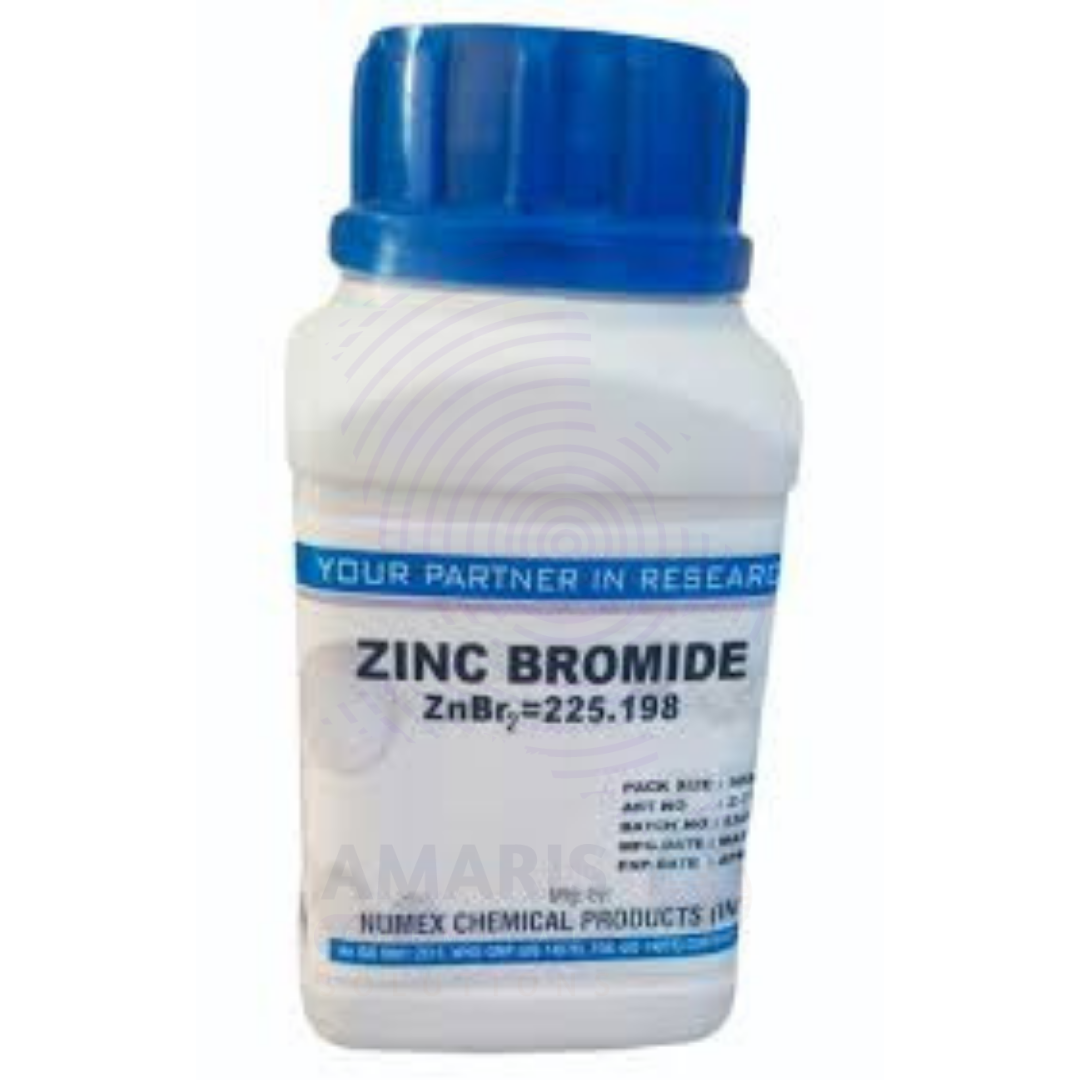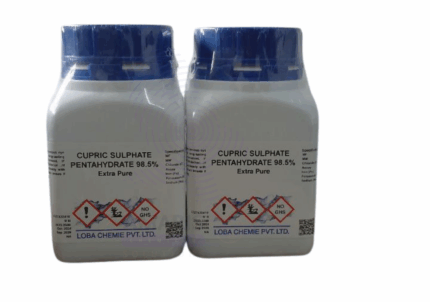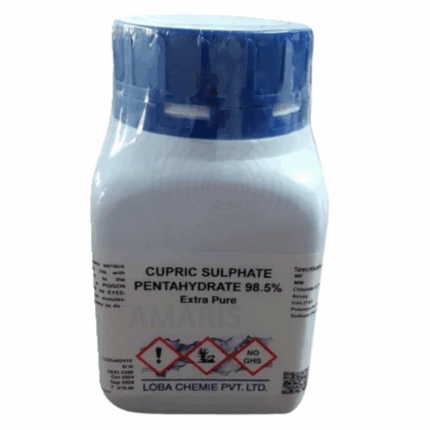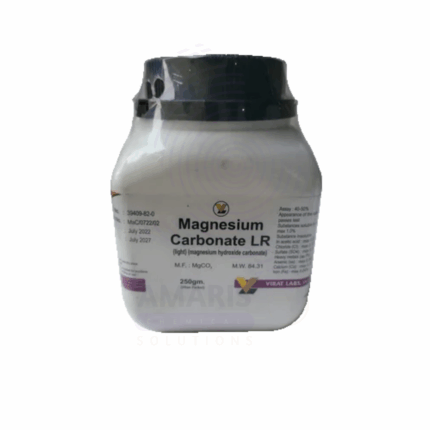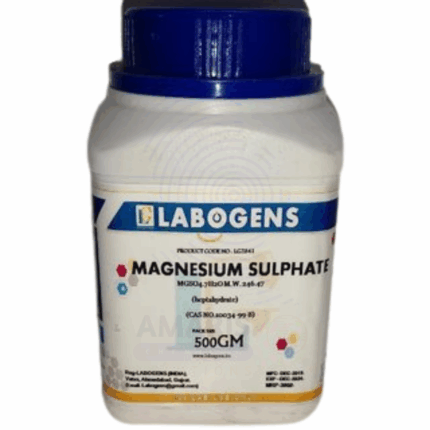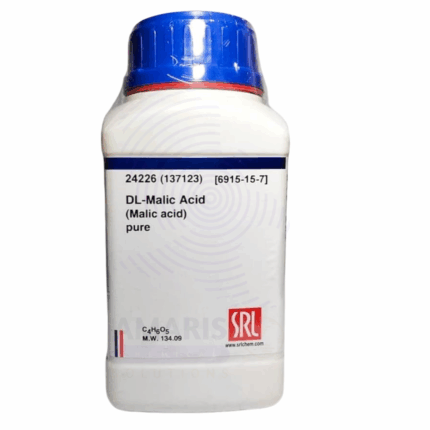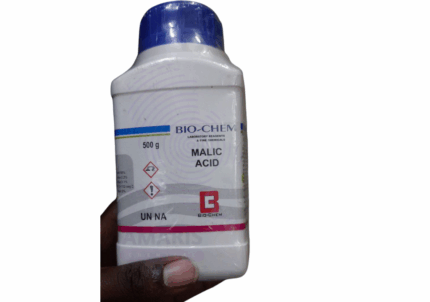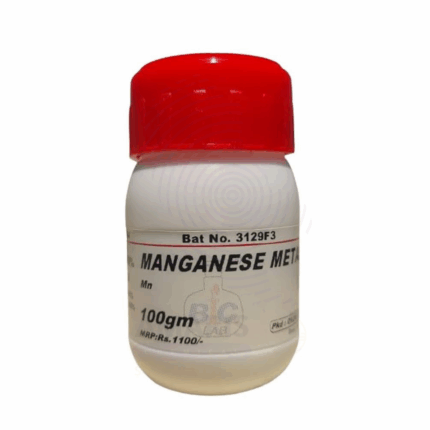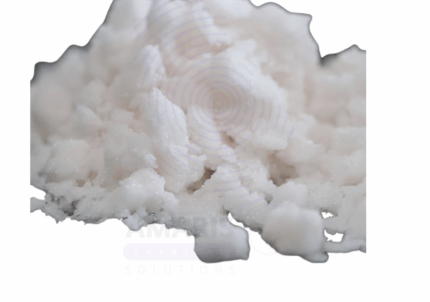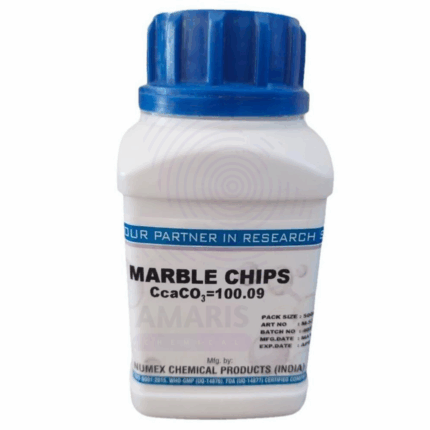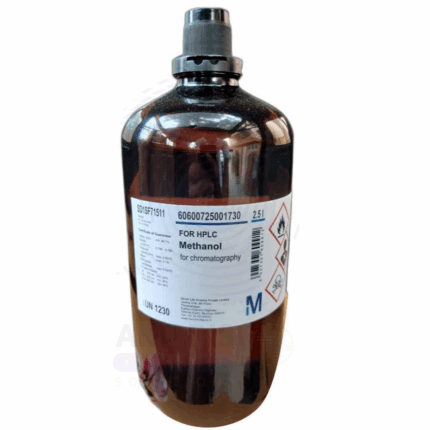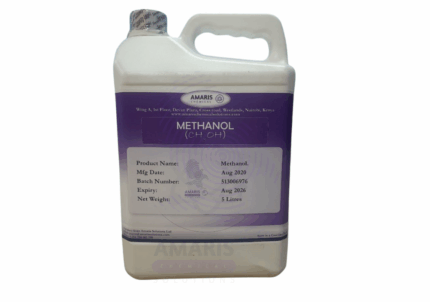

Zinc Bromide Extra Pure
$ 19.11 Original price was: $ 19.11.$ 18.98Current price is: $ 18.98.
Zinc Bromide Extra Pure is a high-purity inorganic compound with the formula ZnBr₂, appearing as a white to off-white crystalline solid. It is highly soluble in water, making it valuable in laboratory and industrial chemical processes requiring both zinc and bromide ions. This compound is widely used in analytical chemistry, organic synthesis, and as a high-density material for industrial applications such as drilling fluids and radiation shielding. Its Extra Pure grade guarantees minimal impurities, ensuring reproducibility and accuracy in research and formulation. Zinc Bromide is stable under normal conditions but requires careful handling due to its potential to cause irritation and its toxicity in aquatic environments. Proper storage involves protection from moisture and incompatible chemicals, with safety measures emphasizing PPE and environmental precautions.
Zinc Bromide Extra Pure
PRIMARY USES
- Analytical Reagent & Laboratory Applications:
- Used as a high-purity zinc and bromide ion source for chemical analysis and synthesis
- Employed in spectroscopic studies and chromatography as a reagent or standard
- Utilized in preparation of buffer solutions and complexation studies involving zinc ions
- Acts as a catalyst or reagent in organic synthesis, particularly in bromination reactions
- Used in titrations and quantitative analysis for bromide or zinc content determination
- Important in electrochemical research for studies involving bromide and zinc ions
- Applied in preparation of solutions for density gradient centrifugation and other lab separation techniques
- Industrial & Chemical Manufacturing:
- Utilized in production of photographic chemicals and specialty chemical intermediates
- Used as a Lewis acid catalyst in various organic transformations
- Important in the manufacture of flame retardants, drilling fluids, and oil field chemicals
- Used in formulation of transparent radiation shielding materials due to its high density
SECONDARY USES
- Oil and Gas Industry:
- Component of high-density drilling and completion fluids for oil well operations
- Used for well stimulation and workover fluids to improve recovery
- Pharmaceutical & Cosmetic Industry:
- Investigated as an antiseptic agent and in formulation of topical applications
- Used in certain niche pharmaceutical syntheses requiring zinc and bromide sources
- Water Treatment & Environmental Applications:
- Used in limited water treatment formulations for microbial control
- Employed in research on halide chemistry in environmental systems
1. Basic Identification Attributes
Chemical Name: Zinc Bromide
CAS Number: 7646-85-7
HS Code: 2827.39.00
Molecular Formula: ZnBr₂
Synonyms:
- Zinc dibromide
- Zinc bromide anhydrous
- Zinc bromide crystalline
2. Physical & Chemical Properties
Physical State: Solid crystalline or granular powder
Color & Odor: White to off-white, odorless
Melting Point: 394 °C (decomposes)
Boiling Point: Decomposes before boiling
Density/Specific Gravity: ~4.47 g/cm³ (anhydrous)
Solubility:
- Highly soluble in water (428 g/100 mL at 20 °C)
- Soluble in ethanol and acetone
pH Level: Slightly acidic to neutral in aqueous solution (pH ~5-7)
Vapor Pressure & Volatility: Low volatility
Flash Point: Not flammable
Autoignition Temperature: Not applicable
Viscosity: Not applicable
3. Safety & Hazard Attributes
Hazard Class (GHS Classification):
- Causes serious eye irritation (Category 2A)
- May cause skin irritation (Category 2)
- Harmful if swallowed (Category 4)
NFPA Ratings: - Health: 2
- Flammability: 0
- Reactivity: 1
Exposure Limits: - No specific OSHA PEL; handle as per standard zinc and bromide compound safety guidelines
Reactivity: - Stable under normal conditions
- Reacts with strong oxidizers and bases
4. Storage & Handling Attributes
Storage Conditions:
- Store in a cool, dry, well-ventilated area
- Keep container tightly closed to avoid moisture absorption
Incompatible Materials: - Strong oxidizing agents
- Strong bases
- Avoid contact with water in large quantities (exothermic dissolution)
Container Type: - Plastic or glass containers recommended
- Tightly sealed drums or bottles
Shelf Life & Expiration Date: - Stable for several years if stored properly
Special Handling Requirements: - Use gloves, eye protection, and protective clothing
- Avoid dust generation and inhalation
5. Regulatory & Compliance Attributes
Regulatory Status:
- Listed under REACH, TSCA, and other chemical inventories
- Approved for industrial and laboratory use
Transportation Restrictions: - Not classified as hazardous for transport but handle with care
Waste Disposal Method: - Dispose of in accordance with local environmental and hazardous waste regulations
6. Environmental & Health Impact
Ecotoxicity:
- Toxic to aquatic organisms at high concentrations
- Avoid release to waterways
Persistence in Environment: - Soluble and mobile in water; may bioaccumulate in aquatic systems
Carcinogenicity/Mutagenicity: - Not classified as carcinogenic or mutagenic
Biodegradability: - Inorganic compound; not biodegradable
SAFETY PRECAUTIONS
Personal Protective Equipment (PPE):
- Wear chemical-resistant gloves (nitrile or neoprene)
- Use safety goggles or face shield
- Wear lab coat or protective clothing
- Use dust mask or respirator if dust generation is possible
Handling:
- Work in a well-ventilated area
- Avoid inhalation and contact with skin and eyes
- Wash hands thoroughly after handling
Storage:
- Store in sealed containers away from incompatible substances
- Keep dry and protected from moisture
FIRST AID MEASURES
Inhalation:
- Move to fresh air immediately
- Seek medical attention if breathing difficulties occur
Skin Contact:
- Wash with soap and water
- Remove contaminated clothing
- Seek medical advice if irritation develops
Eye Contact:
- Rinse immediately with plenty of water for at least 15 minutes
- Seek medical attention promptly
Ingestion:
- Rinse mouth with water
- Do not induce vomiting unless directed
- Seek immediate medical attention
FIRE FIGHTING MEASURES
Flammability:
- Non-flammable solid
Extinguishing Media: - Use water spray, foam, dry chemical, or CO₂
Hazardous Combustion Products: - May release toxic bromine vapors and zinc oxide fumes if heated strongly
Firefighter Protection: - Wear full protective gear and self-contained breathing apparatus (SCBA)


 Preservatives(food)
Preservatives(food) Flavor Enhancers
Flavor Enhancers Acidulants
Acidulants Sweeteners
Sweeteners Antioxidants
Antioxidants Colorants(food)
Colorants(food) Nutraceutical Ingredients (food)
Nutraceutical Ingredients (food) Nutrient Supplements
Nutrient Supplements Emulsifiers
Emulsifiers
 Collectors
Collectors Dust Suppressants
Dust Suppressants Explosives and Blasting Agents
Explosives and Blasting Agents Flocculants and Coagulants
Flocculants and Coagulants Frothers
Frothers Leaching Agents
Leaching Agents pH Modifiers
pH Modifiers Precious Metal Extraction Agents
Precious Metal Extraction Agents
 Antioxidants(plastic)
Antioxidants(plastic) Colorants (Pigments, Dyes)
Colorants (Pigments, Dyes) Fillers and Reinforcements
Fillers and Reinforcements Flame Retardants
Flame Retardants Monomers
Monomers Plasticizers
Plasticizers Polymerization Initiators
Polymerization Initiators Stabilizers (UV, Heat)
Stabilizers (UV, Heat)
 Antifoaming Agents
Antifoaming Agents Chelating Agents
Chelating Agents Coagulants and Flocculants
Coagulants and Flocculants Corrosion Inhibitors
Corrosion Inhibitors Disinfectants and Biocides
Disinfectants and Biocides Oxidizing Agents
Oxidizing Agents pH Adjusters
pH Adjusters Scale Inhibitors( water)
Scale Inhibitors( water)
 Antioxidants(cosmetic)
Antioxidants(cosmetic) Emollients
Emollients Fragrances and Essential Oils
Fragrances and Essential Oils Humectants
Humectants Preservatives
Preservatives Surfactants(cosmetic)
Surfactants(cosmetic) Thickeners
Thickeners UV Filters
UV Filters
 Fertilizers
Fertilizers Soil Conditioners
Soil Conditioners Plant Growth Regulators
Plant Growth Regulators Animal Feed Additives
Animal Feed Additives Biostimulants
Biostimulants Pesticides (Herbicides, Insecticides, Fungicides)
Pesticides (Herbicides, Insecticides, Fungicides)
 Active Pharmaceutical Ingredients (APIs)
Active Pharmaceutical Ingredients (APIs) Excipients
Excipients Solvents(pharmaceutical)
Solvents(pharmaceutical) Antibiotics
Antibiotics Antiseptics and Disinfectants
Antiseptics and Disinfectants Vaccine Adjuvants
Vaccine Adjuvants Nutraceutical Ingredients (pharmaceutical)
Nutraceutical Ingredients (pharmaceutical) Analgesics & Antipyretics
Analgesics & Antipyretics
 Analytical Reagents
Analytical Reagents Solvents(lab)
Solvents(lab) Chromatography Chemicals
Chromatography Chemicals Spectroscopy Reagents
Spectroscopy Reagents microbiology-and-cell-culture-reagents
microbiology-and-cell-culture-reagents Molecular Biology Reagents
Molecular Biology Reagents Biochemical Reagents
Biochemical Reagents Inorganic and Organic Standards
Inorganic and Organic Standards Laboratory Safety Chemicals
Laboratory Safety Chemicals Specialty Laboratory Chemicals(Special Laboratory Equipment)
Specialty Laboratory Chemicals(Special Laboratory Equipment)
 Demulsifiers
Demulsifiers Hydraulic Fracturing Fluids
Hydraulic Fracturing Fluids Scale Inhibitors(oil)
Scale Inhibitors(oil) Surfactants(oil)
Surfactants(oil) Drilling Fluids
Drilling Fluids
 Dyes and Pigments
Dyes and Pigments Bleaching Agents
Bleaching Agents Softening Agents
Softening Agents Finishing Agents
Finishing Agents Antistatic Agents
Antistatic Agents
 Admixtures
Admixtures Waterproofing Agents
Waterproofing Agents Sealants and Adhesives
Sealants and Adhesives Curing Compounds
Curing Compounds Concrete Repair Chemicals
Concrete Repair Chemicals Anti-Corrosion Coatings
Anti-Corrosion Coatings
 Surfactants(cleaning)
Surfactants(cleaning) Builders
Builders Enzymes
Enzymes Solvents (Cleaning)
Solvents (Cleaning) Fragrances
Fragrances
 Electronic Chemicals
Electronic Chemicals Catalysts
Catalysts Lubricants
Lubricants Photographic Chemicals
Photographic Chemicals Refrigerants
Refrigerants Automotive chemicals
Automotive chemicals Pyrotechnic Chemicals
Pyrotechnic Chemicals
 Biodegradable Surfactants
Biodegradable Surfactants Bio-based Solvents
Bio-based Solvents Renewable Polymers
Renewable Polymers Carbon Capture Chemicals
Carbon Capture Chemicals Wastewater Treatment Chemicals
Wastewater Treatment Chemicals
 Pigments
Pigments Solvents(paint)
Solvents(paint) Specialty Coatings
Specialty Coatings Binders/Resins
Binders/Resins Additives
Additives Driers
Driers Anti-Corrosion Agents
Anti-Corrosion Agents Functional Coatings
Functional Coatings Application-Specific Coatings
Application-Specific Coatings
 Fresh Herbs
Fresh Herbs Ground Spices
Ground Spices Whole Spices
Whole Spices Spice Blends
Spice Blends Dried Herbs
Dried Herbs
 Leavening Agents
Leavening Agents Dough Conditioners
Dough Conditioners Flour Treatments
Flour Treatments Fat Replacers
Fat Replacers Decoratives
Decoratives Preservatives(baking)
Preservatives(baking)
 Plasticizers & Softeners
Plasticizers & Softeners Reinforcing Agents
Reinforcing Agents Adhesion Promoters
Adhesion Promoters Vulcanizing Agents
Vulcanizing Agents Antidegradants
Antidegradants Blowing Agents
Blowing Agents Fillers & Extenders
Fillers & Extenders Accelerators & Retarders
Accelerators & Retarders